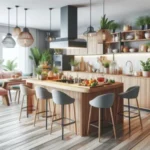Choosing the perfect kitchen countertop material is a crucial step in creating a functional and stylish culinary space.
With countless options available, from timeless natural stones to modern engineered materials, the decision can feel overwhelming. Your countertop is not only a workhorse for meal prep and entertaining but also a focal point that can enhance the overall aesthetic of your kitchen. In this ultimate guide, we will explore the various countertop materials available, highlighting their unique benefits, maintenance requirements, and design potential. Whether you’re seeking durability, elegance, or budget-friendly options, our comprehensive insights will empower you to make an informed choice that aligns with your lifestyle and personal taste. Join us as we delve into the world of kitchen countertops, helping you transform your kitchen into the heart of your home.
1. Introduction to Kitchen Countertop Materials
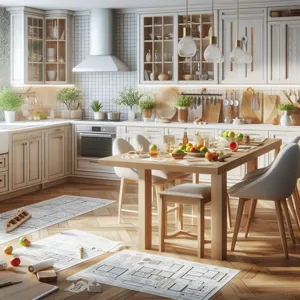
When it comes to designing the heart of your home, the kitchen countertop is a pivotal element that marries functionality with style. Not only do countertops serve as a durable work surface for meal prep and entertaining, but they also play a significant role in the overall aesthetic of your kitchen. With a plethora of options available, choosing the perfect countertop material can feel overwhelming.
From the timeless elegance of granite to the modern sheen of quartz and the rustic warmth of butcher block, each material brings its own unique character and benefits. Your choice will affect not just the look and feel of your kitchen, but also how you use the space day-to-day. Durability, maintenance requirements, and resistance to stains and heat are critical factors to consider as you navigate through the options.
Additionally, your personal style and the overall design theme of your kitchen should guide your selection. Whether you envision a contemporary minimalist space or a cozy farmhouse aesthetic, the right countertop can enhance your vision and tie the entire room together.
In this guide, we will explore various kitchen countertop materials, highlighting their pros and cons, maintenance tips, and ideal design applications. By the end, you’ll be equipped with the knowledge necessary to make an informed decision and create a kitchen that is not only beautiful but also functional for your culinary adventures.
2. Factors to Consider When Choosing Countertop Materials
When it comes to selecting the ideal countertop material for your kitchen, several key factors come into play. Each decision you make can significantly impact both the aesthetics and functionality of your space, so it’s essential to approach this choice with careful consideration.
**1. Durability:** One of the foremost considerations is how well the material will stand up to daily wear and tear. Countertops are subjected to heat, scratches, spills, and stains, so durability is paramount. For instance, granite and quartz are renowned for their resilience, while softer materials like marble may require more maintenance and care to prevent damage.
**2. Maintenance:** Different materials require varying levels of upkeep. Natural stones, such as granite and marble, often need to be sealed regularly to protect against stains and moisture. On the other hand, solid surfaces like Corian or laminate are typically easier to clean and maintain, making them ideal for busy households.
**3. Aesthetic Appeal:** Your kitchen countertop serves as a focal point, contributing significantly to the overall design and feel of the space. Consider the color, pattern, and texture of the materials. For a modern look, sleek quartz or polished concrete might be a fit, while warm wood or rustic butcher block can bring a cozy, inviting vibe.
**4. Budget:** Countertop materials vary widely in price, so it’s important to establish a budget before you start shopping. Natural stones can be more expensive due to quarrying and fabrication costs, while laminate offers an affordable alternative without compromising style.
**5. Functionality:** Think about how you use your kitchen. If you love to cook, you’ll want a surface that can handle heavy use, while someone who primarily uses their kitchen for entertaining might prioritize style over toughness. Additionally, consider if you need extra features like an integrated cutting board or a sink.
**6. Environmental Impact:** As sustainability becomes increasingly important, many homeowners seek materials that are eco-friendly. Bamboo, recycled glass, and sustainably sourced wood are excellent choices for those looking to minimize their environmental footprint.
By weighing these factors carefully, you can ensure that the countertop material you choose not only complements your kitchen’s style but also meets the demands of your lifestyle. Taking the time to evaluate these aspects will lead you to a countertop that you’ll love for years to come.
3. Overview of Popular Countertop Materials
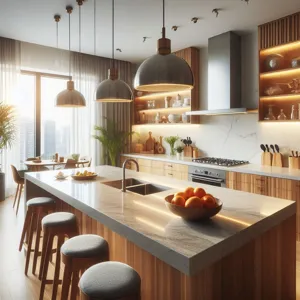
When it comes to selecting the ideal kitchen countertop, the sheer variety of materials available can feel overwhelming. Each option comes with its unique benefits, aesthetics, and maintenance requirements. Here’s a brief overview of some of the most popular countertop materials to help you make an informed choice:
**1. Granite:** Known for its timeless beauty and durability, granite countertops are a favorite among homeowners. Each slab is unique, showcasing natural variations in color and pattern. Highly resistant to heat and scratches, granite requires periodic sealing to maintain its luster and prevent stains.
**2. Quartz:** Engineered for consistency and strength, quartz countertops combine natural quartz crystals with resins, resulting in a non-porous surface that is both beautiful and practical. Available in a myriad of colors and patterns, quartz is easy to maintain and doesn’t require sealing, making it a top choice for busy kitchens.
**3. Marble:** If you desire elegance and luxury, marble is a worthy contender. Renowned for its stunning veining and rich textures, marble adds a sophisticated touch to any kitchen. However, it is softer than granite and quartz, which makes it more susceptible to scratches and stains, necessitating careful maintenance and sealing.
**4. Laminate:** For those on a budget, laminate countertops offer a wide variety of colors and designs, including options that mimic more expensive materials. While they are relatively inexpensive and easy to install, laminate can be less durable and more prone to damage from heat and sharp objects.
**5. Butcher Block:** Ideal for those who enjoy cooking, butcher block countertops provide a warm, inviting look and a functional surface for food prep. They are made from strips of wood glued together and can be refinished as needed. However, regular oiling is essential to prevent warping and maintain their appearance.
**6. Concrete:** For a modern, industrial feel, concrete countertops are a bold choice. They can be customized in terms of color and finish, providing a unique look. While they are incredibly durable, they require sealing to prevent stains and scratches, and they can be heavy, necessitating proper support.
**7. Solid Surface:** Composed of acrylic and other materials, solid surface countertops are versatile, easy to clean, and available in a wide range of colors and patterns. They can be seamlessly integrated into sinks and backsplashes, but can be susceptible to scratching and heat damage.
As you consider these popular materials, think about your kitchen’s style, your cooking habits, and the level of maintenance you’re willing to undertake. Each material has its own charm and functionality, so take the time to weigh your options before making a decision that enhances both the beauty and practicality of your kitchen.
– 3.1. Granite
### 3.1. Granite
Granite is a timeless choice for kitchen countertops, revered not only for its stunning aesthetic appeal but also for its unmatched durability. This natural stone, formed from molten rock, boasts a unique blend of colors and patterns, ensuring that no two slabs are exactly alike. With its rich speckles and swirling hues, granite can add a touch of luxury to any kitchen, whether your style leans towards rustic farmhouse or sleek modern.
One of granite’s standout features is its resilience. It is highly resistant to scratches and heat, making it an ideal surface for cooking and food preparation. You can set down a hot pan straight from the oven without worrying about damaging the surface. Additionally, granite’s non-porous quality, when properly sealed, helps to prevent stains from coffee, wine, and other common kitchen spills. This means that not only does it look great, but it’s also practical for everyday use.
However, it’s essential to note that while granite is durable, it does require some maintenance. Regular sealing—typically every one to two years—helps to maintain its beauty and protective properties. Moreover, while some homeowners may be intimidated by the prospect of sealing, it is a relatively straightforward process that can be easily managed with a few simple steps.
Granite countertops are available in a wide variety of colors, ranging from deep blacks and bright whites to vibrant greens and browns, allowing you to find the perfect match for your kitchen’s color scheme. Whether you prefer a polished finish that reflects light beautifully or a honed finish that offers a more matte look, granite can be tailored to suit your personal style.
In conclusion, if you’re looking for a countertop material that combines elegance, functionality, and durability, granite is an exceptional choice. Its natural beauty and resilience can elevate your kitchen, making it a space that is not only beautiful but also highly practical for everyday living.
– 3.2. Quartz
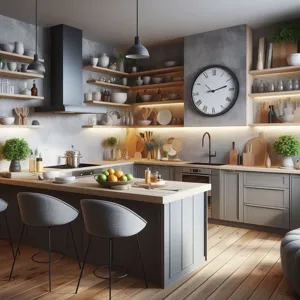
### 3.2. Quartz
When it comes to choosing a kitchen countertop material that seamlessly blends durability with elegance, quartz stands out as an exceptional option. This engineered stone, made from a combination of about 90% crushed natural quartz crystals and resins, offers a stunningly versatile surface that can suit any kitchen style, from contemporary to traditional.
One of the most compelling features of quartz countertops is their resilience. Unlike natural stones such as granite or marble, quartz is non-porous, which means it doesn’t harbor bacteria or absorb stains. This characteristic not only enhances its hygiene but also makes maintenance a breeze. A simple wipe with warm, soapy water is often all that’s needed to keep your quartz countertop looking pristine.
Moreover, quartz countertops are available in a vast array of colors and patterns, allowing homeowners to express their unique style. Whether you prefer the look of classic white, deep black, or vibrant hues, there’s a quartz countertop that can perfectly match your kitchen’s aesthetic. Many manufacturers even offer designs that mimic the intricate veining of natural stone, providing the beauty of marble or granite without the associated upkeep.
Another advantage of quartz is its durability. It is resistant to scratching and chipping, making it an ideal choice for busy kitchens where culinary creativity is a daily occurrence. Additionally, quartz can withstand heat to a certain degree, but using trivets for hot pots and pans is still advisable to prolong its lifespan.
In terms of investment, quartz countertops may come with a higher upfront cost compared to some other materials. However, their longevity and low maintenance requirements often make them a cost-effective choice in the long run. When you choose quartz, you’re not just enhancing the visual appeal of your kitchen; you’re also investing in a functional and enduring surface that can withstand the rigors of daily life.
Overall, quartz countertops provide a perfect balance of beauty, functionality, and ease of care, making them a top contender for anyone looking to elevate their kitchen space. Whether you’re cooking, entertaining, or simply enjoying a quiet moment with your morning coffee, a quartz countertop will serve as a stunning centerpiece that enhances your culinary experience.
– 3.3. Marble
### 3.3. Marble
Marble countertops are the epitome of elegance and timeless beauty, making them a favored choice for homeowners looking to elevate their kitchen’s aesthetic. With their stunning veining and unique patterns, no two slabs of marble are alike, which means your kitchen will truly be one-of-a-kind. The luxurious appearance of marble can instantly transform a space, adding a touch of sophistication that is particularly appealing in both traditional and modern designs.
Beyond their visual appeal, marble countertops are known for their cool surface, making them an ideal workspace for pastry chefs and bakers who require a chilled area for dough preparation. However, this beautiful stone does come with some considerations. Marble is softer and more porous than other materials, which means it can be prone to scratching and staining if not properly cared for. It’s essential to seal your marble countertops regularly to protect them from spills—especially acidic liquids like lemon juice or vinegar, which can etch the surface.
In terms of maintenance, a gentle cleanser and a soft cloth can keep your marble looking stunning. While it may require a bit more attention than granite or quartz, the allure of marble is undeniable. Its ability to blend seamlessly with various color palettes and textures makes it a versatile option for any kitchen style, from classic white marble with gray veining to vibrant colored marbles that can serve as a statement piece.
If you’re seeking to create a kitchen that is both functional and breathtakingly beautiful, marble countertops may just be the perfect choice, combining artistic flair with culinary practicality. Just remember, investing in marble is not just about the initial appeal; it’s about embracing a material that tells a story of elegance and history with every use.
– 3.4. Laminate
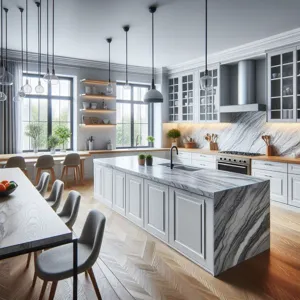
### 3.4. Laminate
Laminate countertops have long been a favorite choice for homeowners seeking an affordable yet stylish option for their kitchens. Available in an extensive array of colors, patterns, and textures, laminate surfaces can mimic the appearance of more expensive materials like granite or marble, allowing you to achieve the look you desire without breaking the bank.
One of the standout features of laminate is its versatility. With options ranging from vibrant hues to subtle earth tones, you can easily find a laminate that complements your kitchen’s design aesthetic. Modern laminate finishes can even replicate the natural veining of stone, offering a contemporary twist on traditional materials. This flexibility makes laminate an excellent choice for both retro and modern kitchens alike.
In addition to aesthetics, laminate countertops are known for their practicality. They are non-porous, which means they resist stains and won’t harbor bacteria, making them a hygienic option for food preparation. Routine cleaning is a breeze—often requiring just a damp cloth and mild soap to maintain their appearance. However, it is worth noting that while laminate is resistant to stains, it is not as durable as stone or solid surface materials. Sharp knives and hot pans can damage the surface, so using cutting boards and trivets is essential to prolonging its lifespan.
Affordability is another significant advantage of laminate countertops. They typically cost a fraction of what you would pay for natural stone, making them an ideal choice for budget-conscious homeowners or those looking to renovate without a hefty investment. Plus, the installation process is generally straightforward, which can translate to savings on labor costs if you decide to take the DIY route.
In summary, laminate countertops offer a winning combination of style, affordability, and practicality. Whether you’re renovating an entire kitchen or simply looking to update your workspace, laminate is a material worth considering for its diverse options and ease of maintenance.
– 3.5. Butcher Block
### 3.5. Butcher Block
Butcher block countertops are a warm and inviting choice for any kitchen, blending functionality with a rustic charm that can elevate the aesthetic of your space. Made from straight cuts of wood glued together into a thick slab, these countertops offer a natural beauty that is hard to replicate with other materials. The rich grains and varied hues of wood bring a sense of warmth and coziness, making your kitchen feel like the heart of your home.
One of the standout features of butcher block is its versatility. Whether you opt for maple, oak, walnut, or cherry, each type of wood has its unique character and can complement various design styles—from modern to farmhouse chic. The surface is not only visually appealing but also incredibly practical, providing a durable work area for chopping, slicing, and dicing. Unlike some harder surfaces that can dull your knives, butcher block is gentle on blades, ensuring they remain sharp longer.
However, potential buyers should be aware that butcher block does require a bit more maintenance than other materials. Regular oiling is necessary to keep the wood hydrated and prevent it from cracking or warping over time. Additionally, wood is susceptible to scratches and dents, but many homeowners appreciate that these imperfections can add to the character of the countertop. A light sanding can often restore its original luster, making it a relatively simple process to keep it looking its best.
When it comes to hygiene, butcher block countertops can be a safe choice if properly cared for. Wood has natural antimicrobial properties that can help resist bacteria, but it’s essential to clean up spills promptly and maintain a regular cleaning schedule. With the right care, butcher block countertops can last for years, becoming a cherished part of your kitchen that tells a story of culinary adventures and family gatherings.
In summary, if you’re looking for a countertop material that combines beauty, functionality, and a touch of warmth, butcher block is an exceptional choice. It invites creativity into the kitchen and provides a welcoming space for cooking and entertaining, making it a worthy contender in your search for the perfect kitchen countertop.
– 3.6. Concrete
### 3.6. Concrete
Concrete countertops are rapidly gaining traction in the world of kitchen design, and for good reason. Not only do they exude a modern, industrial vibe, but they also offer unparalleled durability and versatility. Available in a wide array of finishes, colors, and textures, concrete can be tailored to fit any aesthetic—from sleek and contemporary to rustic and organic.
One of the standout features of concrete countertops is their ability to be molded into custom shapes and sizes, allowing for unique designs that can perfectly complement your kitchen layout. Unlike traditional materials, concrete can be cast directly into place, creating seamless surfaces that enhance both functionality and visual appeal. This flexibility makes it an ideal choice for homeowners looking to make a statement or accommodate unconventional spaces.
Moreover, concrete is inherently heat-resistant, making it a practical choice for avid cooks who often place hot pots and pans directly on their countertops. Additionally, with proper sealing, concrete surfaces can be resistant to stains and moisture, although maintenance is crucial to ensure longevity. Regular sealing helps protect the surface from wear, ensuring that your investment remains beautiful and functional over the years.
Another intriguing aspect of concrete countertops is the opportunity for personalization. You can incorporate colorful aggregates, glass chips, or even embedded items like shells or stones to create a one-of-a-kind surface that reflects your personality and style. This level of customization allows homeowners to showcase their creativity and design flair, turning their kitchen into a true work of art.
However, potential buyers should be aware that concrete countertops can be heavy, requiring sturdy cabinetry and professional installation. Additionally, while they can be incredibly durable, they are not impervious to cracking if not properly cared for.
In conclusion, if you’re looking for a countertop material that combines strength, style, and individuality, concrete is an excellent choice. With its modern aesthetic and customizable options, it can elevate your kitchen from ordinary to extraordinary, making it a perfect fit for those who dare to think outside the box.
– 3.7. Soapstone
### 3.7. Soapstone
Soapstone is a natural stone that has captured the hearts of many homeowners and designers alike, thanks to its unique aesthetic appeal and practical benefits. This metamorphic rock is composed primarily of talc, giving it a soft, smooth texture that feels luxurious under the fingertips. The color palette of soapstone ranges from soft grays and blues to deep greens and browns, often featuring stunning veining that adds character and depth to any kitchen.
One of the standout qualities of soapstone is its remarkable durability. Unlike some other natural stones, soapstone is non-porous, which means it won’t stain or harbor bacteria, making it an excellent choice for culinary spaces. Its ability to withstand heat is another plus; you can place hot pots and pans directly on the surface without fear of damage. While it may scratch more easily than harder stones like granite or quartz, these scratches can be easily sanded out, allowing the countertop to maintain its beauty over time.
Maintenance is relatively straightforward with soapstone. A simple application of mineral oil can enhance its color and luster, while regular cleaning with mild soap and water keeps it looking fresh. This low-maintenance requirement is a significant advantage for busy households that value both aesthetics and functionality.
In terms of style, soapstone brings a rustic yet sophisticated ambiance to the kitchen. Its natural variations in color and pattern ensure that no two slabs are exactly alike, giving each installation a unique charm. Whether you’re aiming for a contemporary, farmhouse, or traditional design, soapstone can seamlessly complement your vision.
With its blend of beauty, practicality, and timeless appeal, soapstone stands out as a superb choice for kitchen countertops, offering a perfect balance of luxury and functionality. If you’re seeking a surface that embodies both elegance and durability, consider embracing the allure of soapstone for your culinary haven.
4. Pros and Cons of Each Material
When it comes to selecting the perfect kitchen countertop material, understanding the pros and cons of each option is essential for making an informed decision. Each material brings its own unique set of characteristics, advantages, and potential drawbacks, which can significantly impact your kitchen’s functionality and aesthetics.
**Granite:**
Pros: Renowned for its durability and heat resistance, granite countertops offer a classic elegance with a unique natural pattern that can enhance any kitchen’s aesthetic. They are also relatively low-maintenance, requiring only periodic sealing to protect against stains.
Cons: However, the initial cost can be quite high, and heavier slabs may necessitate additional structural support. Additionally, while durable, granite can crack or chip if subjected to extreme force.
**Quartz:**
Pros: Engineered for perfection, quartz countertops boast a non-porous surface that is resistant to staining and bacterial growth, making them extremely hygienic. They come in a variety of colors and patterns, allowing for greater design flexibility.
Cons: Despite their durability, quartz surfaces can be sensitive to heat, and prolonged exposure to high temperatures can cause damage. Furthermore, they can be somewhat expensive, similar to granite, which might not fit every budget.
**Marble:**
Pros: Marble exudes luxury and sophistication, often regarded as the choice for high-end kitchens. Its unique veining patterns and soft colors can make a striking statement in any space.
Cons: On the downside, marble is more porous and prone to scratching and staining than other materials. It requires regular sealing and careful maintenance to keep it looking pristine, which might not suit every homeowner’s lifestyle.
**Laminate:**
Pros: Affordable and available in a myriad of colors and styles, laminate countertops are a versatile option for budget-conscious homeowners. They are easy to clean and can mimic the appearance of more expensive materials.
Cons: However, laminate is less durable than other options and can be susceptible to scratching and heat damage. Once damaged, it’s often difficult to repair, which could lead to the need for a complete replacement.
**Wood (Butcher Block):**
Pros: Wood countertops offer warmth and a natural aesthetic that can create a cozy kitchen environment. They are great for food preparation and can be sanded down and refinished when they wear over time.
Cons: On the flip side, wood is susceptible to scratches, dents, and water damage if not properly maintained. Regular oiling is required to keep the wood in good condition, and it may not be suitable for all cooking styles, especially if you frequently work with raw meats.
In summary, the choice of countertop material is influenced not only by your aesthetic preferences but also by how much maintenance you’re willing to undertake, your cooking habits, and your budget. By weighing the pros and cons of each option, you can select a countertop that perfectly aligns with your lifestyle and enhances the heart of your home.
5. Cost Comparison of Different Countertop Materials
When it comes to selecting the perfect kitchen countertop, understanding the cost implications of different materials is crucial. Your choice not only impacts your budget but also affects the overall aesthetic and functionality of your kitchen. Here’s a comparative breakdown of some popular countertop materials to help you navigate your options.
**Granite**: Known for its durability and natural beauty, granite countertops typically range from $40 to $100 per square foot, depending on the quality and rarity of the stone. While the initial investment might be higher, granite’s resistance to heat and scratches makes it a long-lasting choice, often adding significant value to your home.
**Quartz**: Engineered from natural stone and resin, quartz countertops offer a range of colors and patterns, mimicking the look of more expensive materials. Prices generally fall between $50 to $150 per square foot. Though slightly pricier than granite, quartz is non-porous and requires less maintenance, making it an appealing choice for busy kitchens.
**Marble**: With its timeless elegance, marble countertops are often favored for their luxurious appearance. However, they come with a steeper price tag, often ranging from $50 to $200 per square foot. The beauty of marble is undeniable, but be mindful that it is softer and more prone to scratching and staining, which may result in higher maintenance costs over time.
**Laminate**: For those on a tighter budget, laminate countertops present a cost-effective option, ranging from $10 to $50 per square foot. Available in a myriad of colors and designs, laminate offers versatility but lacks the durability of stone materials. It’s a suitable choice for individuals who prioritize budget over longevity.
**Butcher Block**: If you love the warmth of wood, butcher block countertops can be a charming addition to your kitchen. Prices typically range from $30 to $150 per square foot, depending on the type of wood and finish. While they provide a rustic appeal and are great for food preparation, they require regular oiling and can be susceptible to scratches and water damage.
**Concrete**: For a modern and industrial look, concrete countertops are gaining popularity. Prices generally start around $65 per square foot and can go up significantly depending on the design and finish. Concrete is incredibly durable but requires sealing to prevent stains and damage from moisture.
When comparing costs, it’s essential to factor in not just the price per square foot, but also the long-term maintenance and durability of the material. Each option comes with its own set of pros and cons, so consider how each will fit into your lifestyle and budget before making a decision. By carefully evaluating these elements, you can choose a countertop material that not only meets your aesthetic desires but also falls within your financial comfort zone.
6. Durability and Maintenance Requirements
When selecting the perfect kitchen countertop material, durability and maintenance requirements should be at the forefront of your decision-making process. After all, your kitchen is one of the most used spaces in your home, and your countertop endures a multitude of daily tasks—from chopping vegetables to rolling out dough and holding hot pots straight from the stove.
Durability varies significantly among countertop materials. For instance, granite and quartz are renowned for their strength and resistance to scratches and heat, making them ideal for bustling kitchens. Conversely, softer stones like limestone or marble, while undeniably beautiful, can be susceptible to etching and staining, requiring more careful handling and regular sealing to maintain their appearance.
Maintenance is another critical factor to consider. Some materials, like laminate or solid surface countertops, offer low-maintenance options that only require simple cleaning with soap and water. In contrast, natural stones often demand more upkeep, including periodic resealing and specialized cleaners to preserve their luster and integrity.
Think about your lifestyle and cooking habits when evaluating durability and maintenance. If you frequently entertain or have a busy family kitchen, a robust and lower-maintenance option may serve you better in the long run. On the other hand, if you’re looking for a countertop that showcases elegance and are willing to invest time in care, materials like marble could be a stunning centerpiece for your culinary haven.
Ultimately, understanding the balance between durability and maintenance can help you choose a countertop that not only enhances your kitchen’s aesthetic appeal but also withstands the test of time and everyday use. Prioritize your kitchen needs, and you’ll find a countertop that perfectly aligns with your lifestyle.
7. Aesthetic Considerations: Color and Texture
When it comes to selecting the perfect kitchen countertop material, aesthetic considerations such as color and texture play a pivotal role in defining the overall look and feel of your culinary space. The countertop is often the centerpiece of the kitchen, and its visual appeal can dramatically influence the ambiance of the room.
Start by considering the color palette you envision for your kitchen. Are you leaning towards a modern, minimalist vibe with sleek whites and grays, or do you prefer the warmth of earthy tones that evoke a rustic charm? The right color can either complement your existing décor or serve as a bold statement piece. For example, a deep navy or emerald green granite can add a luxurious touch, while a bright white quartz surface can create an airy, spacious look.
Texture is another vital element that should not be overlooked. The surface finish of your countertops can range from smooth and glossy to textured or honed, each offering a distinct character and feel. A polished granite countertop radiates elegance and is easy to clean, making it ideal for a chic, contemporary kitchen, while a matte-finished soapstone can lend a more organic, artisanal appeal.
Additionally, consider how the texture interacts with the other materials in your kitchen. A rough, natural stone can provide a beautiful contrast against sleek cabinetry or smooth appliances. On the other hand, if your kitchen features a lot of intricate tile work or bold backsplashes, opting for a more subdued countertop can help maintain a balanced aesthetic.
Ultimately, the key is to choose colors and textures that resonate with your personal style and harmonize with the overall design of your kitchen. By thoughtfully considering these aesthetic elements, you can create a kitchen space that not only functions beautifully but also reflects your unique taste and enhances the joy of cooking and gathering with loved ones.
8. Eco-Friendly Countertop Options
As sustainability becomes a focal point for many homeowners, eco-friendly countertop options are gaining traction in kitchen design. Choosing environmentally friendly materials not only benefits our planet but often enhances the aesthetic and functional qualities of your kitchen.
Recycled glass countertops, for example, are a stunning choice that combines beauty and sustainability. These surfaces are made from post-consumer glass, which is crushed and mixed with resins to create a vibrant and unique finish. The kaleidoscope of colors and patterns not only reduces waste but also adds a modern flair to your kitchen.
Another excellent choice is bamboo, a rapidly renewable resource that is both durable and stylish. Bamboo countertops have a rich, warm appearance and are less likely to harbor bacteria, making them a hygienic option for food preparation. Their natural look complements a variety of design styles, from rustic to contemporary.
For a truly timeless and sustainable solution, consider using reclaimed wood. With its rich history and character, reclaimed wood brings a unique story to your kitchen. By repurposing materials that would otherwise end up in landfills, you’re making an environmentally responsible choice while enjoying the beauty of natural wood grains and textures.
Lastly, consider using concrete, which can be made with eco-friendly aggregates and can be colored and shaped to fit your design preferences. Concrete is incredibly durable and, when sealed properly, can withstand heat and moisture, making it a long-lasting option.
Opting for eco-friendly countertops not only allows you to create a stunning kitchen but also aligns your choices with a commitment to sustainability. By selecting materials that are kind to the Earth, you can enjoy a space that reflects your values while providing functionality and beauty.
9. Trends in Kitchen Countertops for Modern Homes
The world of kitchen design is ever-evolving, and keeping up with the latest trends in countertops can transform your culinary space into a modern masterpiece. As homeowners increasingly prioritize style alongside functionality, several key trends have emerged that are defining the contemporary kitchen aesthetic.
One of the most prominent trends is the rise of natural materials, particularly quartzite and granite, which offer durability while showcasing the unique veining and patterns found in nature. These stones not only add a touch of luxury but also provide a timeless appeal that can seamlessly blend with various design styles, from rustic to sleek and modern.
Another trend gaining traction is the use of bold colors and dramatic finishes. Homeowners are moving away from the traditional monochromatic palettes and opting for vibrant hues like deep blues, emerald greens, and even striking blacks. This shift allows for a stunning focal point in the kitchen, encouraging creativity and personal expression in design. Matte finish surfaces are also becoming increasingly popular, as they offer a contemporary look and are less prone to showing fingerprints and smudges compared to glossy finishes.
Sustainability is another critical factor shaping countertop choices in modern homes. Many homeowners are opting for eco-friendly materials, such as recycled glass or sustainably sourced wood, which not only reduce environmental impact but also add a unique flair to the kitchen. These materials often come with intriguing textures and colors, making each countertop a conversation piece.
Lastly, the integration of technology in kitchen countertops is on the rise. Features such as built-in wireless charging stations or smart surfaces that can change color or display information are becoming more commonplace. These innovations not only enhance functionality but also cater to the tech-savvy homeowner’s desire for a seamless, modern lifestyle.
By staying attuned to these trends, you can choose a countertop material that not only fits your personal style but also enhances the overall functionality and aesthetic of your kitchen, making it a true reflection of modern living.
10. How to Match Countertops with Your Kitchen Design
When it comes to selecting the ideal kitchen countertop material, harmonizing it with your overall kitchen design is paramount. The countertop is often the focal point of the kitchen, influencing not only the aesthetic but also the functionality of the space. Here are some practical tips on how to achieve that perfect match.
First, consider the color palette of your kitchen. If you have a modern design with sleek cabinetry and minimalist decor, a solid surface countertop in a neutral hue like white or gray can enhance that clean, contemporary look. On the other hand, if your kitchen features rustic elements, such as reclaimed wood or farmhouse-style cabinetry, a richly veined granite or a warm butcher block can add that touch of earthiness that complements the overall theme.
Next, pay attention to the textures and finishes. A glossy quartz countertop can provide a striking contrast against matte cabinetry, creating a vibrant visual dynamic. Conversely, if your kitchen embraces a softer, more organic feel, opting for a honed or brushed finish can impart warmth and approachability, ensuring a cohesive flow throughout the space.
Don’t forget about the shape and layout of your kitchen! In open-concept designs, where the kitchen flows into living or dining areas, it’s essential to choose a countertop that aligns with adjacent spaces. For instance, if your dining room features dark wood, consider a countertop that echoes that tone, whether through color or material, to create a seamless transition.
Finally, think about your kitchen’s functionality. If you frequently entertain or cook, durability should be a priority. Materials like granite or quartz not only provide aesthetic appeal but also withstand the rigors of daily use. Meanwhile, if your kitchen is more of a casual space, a softer material like laminate might suffice, allowing for playful designs that can easily be updated.
In essence, matching your countertops with your kitchen design involves a delicate balance of color, texture, and functionality. By taking the time to consider these elements, you can create a kitchen that not only looks stunning but also serves as a welcoming hub for family and friends.
11. Real-Life Examples and Case Studies
When it comes to choosing the perfect kitchen countertop material, sometimes the best insights come from real-life examples and case studies. These narratives not only illustrate the practical applications of various materials but also highlight the unique challenges and triumphs homeowners have experienced in their kitchen renovations.
Take, for instance, the Johnson family, who opted for a stunning quartz countertop in their newly remodeled kitchen. Initially drawn to the durability and low maintenance of quartz, they found that it not only stood up to daily wear and tear but also became the focal point of their space. The vibrant veining and rich color palette complemented their modern aesthetic beautifully. However, they quickly learned the importance of choosing a finish that matched their lifestyle; the polished surface required regular cleaning to maintain its shine. Their experience emphasizes the need to consider not just the look but the upkeep involved in your choice.
On the other hand, the Ramirez household decided to go with a classic granite countertop, drawn by its natural beauty and variety. They faced a challenge during installation when they discovered that the stone had a particularly porous surface, leading them to invest in a high-quality sealant to protect against stains. Their proactive approach paid off, as years later, the granite remained a striking feature of their kitchen, proving that with proper care, a natural stone can withstand the test of time.
In a contrasting scenario, a young couple chose butcher block countertops for their cozy, farmhouse-style kitchen. This decision was influenced by their love for cooking and the warmth that wood brings to a space. However, they soon realized that the surface demanded more attention than they anticipated. Regular oiling and careful maintenance became part of their routine, but they were rewarded with a unique, inviting surface that only improved with age. Their journey highlights the beauty and practicality of wood, while underscoring the commitment required to keep it looking its best.
These case studies reveal invaluable lessons: the importance of aligning your countertop choice with your personal style, cooking habits, and maintenance preferences. By learning from the experiences of others, you can navigate the vast array of options available and choose a material that not only enhances your kitchen’s aesthetic but also fits seamlessly into your lifestyle. From the practicalities of installation to the realities of everyday use, these stories serve as guiding beacons for anyone embarking on their countertop selection journey.
12. Tips for Installation and Professional Help
When it comes to installing your new kitchen countertop, understanding the nuances of the process is crucial for achieving a flawless finish. While some daring DIY enthusiasts might consider tackling the installation themselves, it’s important to weigh the complexities of the project against your skill level and experience. Here are some essential tips to ensure a successful installation, whether you choose to go the DIY route or hire a professional.
First and foremost, always measure your space accurately. Precise measurements will help you avoid costly mistakes and ensure that your new countertop fits perfectly. If you’re opting for a material that requires cutting, such as granite or quartz, it’s advisable to leave the cutting and shaping to the professionals. These materials can be unforgiving, and a single slip can lead to a damaged piece that is not only unsightly but also expensive to replace.
If you decide to hire a professional, do your research. Look for contractors who specialize in countertop installation and check their reviews, portfolios, and credentials. Ask for recommendations from friends or family who have recently completed similar projects. A skilled professional will not only ensure that the installation is done correctly but will also provide valuable insight into the best practices for maintaining your countertop once it’s in place.
Additionally, consider the timeline of your project. Countertop installation can take anywhere from a few hours to a couple of days, depending on the material and the complexity of the job. Be sure to coordinate with your contractor to set a schedule that works for both parties and allows for any necessary adjustments.
Lastly, don’t overlook the importance of post-installation care. Make sure to ask your installer about the best ways to care for your new countertop, including recommended cleaning products and maintenance routines. By taking the time to properly install and care for your countertop, you’ll ensure that it remains a stunning centerpiece in your kitchen for years to come.
13. Common Mistakes to Avoid When Choosing Countertops
When embarking on the journey to choose the perfect kitchen countertop, it’s easy to get swept up in the excitement of colors, patterns, and finishes. However, avoiding common pitfalls can save you both time and money while ensuring your kitchen remains functional and stylish for years to come. Here are some of the most prevalent mistakes to steer clear of:
**1. Ignoring Practicality:** One of the biggest missteps is focusing solely on aesthetics without considering how the material will hold up to daily use. For instance, while natural stone like marble can provide a stunning visual appeal, it is prone to scratches and stains, making it less ideal for high-traffic kitchens. Always balance beauty with durability based on your cooking habits.
**2. Overlooking Maintenance Requirements:** Each countertop material has its own set of maintenance needs. Some materials, like butcher block, require regular oiling and sealing to maintain their appearance, while others, such as quartz, are relatively low-maintenance. Failing to consider how much time and effort you’re willing to invest in upkeep can lead to regret down the line.
**3. Neglecting the Overall Design:** Your countertop is a significant component of your kitchen’s aesthetic, but it shouldn’t be the sole focus. Be sure to consider how your chosen material complements the cabinetry, flooring, and overall design theme of your kitchen. A countertop that clashes with the rest of the space can create a disjointed look.
**4. Misjudging Budget Constraints:** High-end materials can be tempting, but they often come with a price tag that may not fit into your budget, especially when you factor in installation costs. It’s important to set a realistic budget beforehand and explore options within that range. Remember, there are many cost-effective materials that can mimic the look of more expensive options without sacrificing quality.
**5. Failing to Test Samples:** Don’t rush the decision-making process. Always request samples of your top choices and take the time to see how they look in your kitchen’s lighting. The appearance of a countertop can change dramatically from showroom to home, so testing samples against your cabinets and appliances is crucial.
By steering clear of these common mistakes, you can make a well-informed decision that ensures your kitchen countertop not only enhances the beauty of your space but also meets your functional needs, ultimately creating a harmonious and inviting kitchen environment.
14. Conclusion: Finding the Right Fit for Your Kitchen
In conclusion, choosing the perfect kitchen countertop material is a decision that extends far beyond aesthetics; it impacts functionality, maintenance, and overall kitchen enjoyment. With a plethora of options available—from the timeless elegance of granite and the sleek modernity of quartz to the warmth of wood and the unique character of concrete—each material brings its own set of advantages and considerations.
As you embark on this journey, take the time to assess your cooking habits, lifestyle, and personal taste. Consider how much wear and tear your countertops will endure, how often you entertain guests, and your preferences for maintenance. It’s essential to balance beauty with practicality; a stunning countertop should not only enhance your kitchen’s visual appeal but also serve you well in daily use.
Involve your family in the decision-making process, as they will be the ones interacting with the space just as much as you are. Don’t forget to explore samples in person, as colors and textures can differ dramatically under various lighting conditions.
Ultimately, the right countertop will harmonize with your kitchen’s design while meeting your functional needs, creating a space where culinary creativity flourishes and memories are made. With careful consideration and a clear understanding of your options, you can confidently select a countertop that reflects your style and stands the test of time. Happy countertop hunting!
15. Additional Resources and Next Steps
As you embark on the journey to select the perfect kitchen countertop material, it’s essential to arm yourself with all the right resources and knowledge to make an informed decision. The landscape of countertop options is vast, each material offering unique benefits, aesthetics, and price points. To guide you through this process, we’ve compiled a list of additional resources that can help deepen your understanding and refine your choices.
First, consider visiting showrooms and home improvement stores where you can see and feel the materials in person. Experiencing the texture, color, and finish of various options like granite, quartz, laminate, or butcher block can provide invaluable insight that photographs simply can’t convey. Additionally, many suppliers offer samples that you can take home, allowing you to visualize how a particular material will look in your kitchen’s lighting and alongside your cabinetry and flooring.
Next, delve into online platforms and forums dedicated to home improvement. Websites like Houzz and Pinterest are treasure troves of design inspiration, featuring real-life kitchens that can spark ideas for your own space. Engaging with communities on these platforms can also connect you with others who have gone through the same process, offering tips and recommendations based on their experiences.
Don’t overlook the importance of professional advice. Consulting with a kitchen designer or a contractor can provide you with personalized recommendations tailored to your specific needs and lifestyle. They can help assess your space, suggest layouts, and guide you toward materials that align with your budget and preferences.
Finally, as you weigh your options, take advantage of resources that detail the maintenance and longevity of each material. Understanding how each countertop will wear over time will help you choose one that not only looks great but also stands the test of time.
In conclusion, the journey to find the perfect kitchen countertop is a blend of personal taste, practical considerations, and a wealth of information at your fingertips. By leveraging these resources and taking the time to evaluate your choices carefully, you’ll be well on your way to transforming your kitchen into a beautiful and functional space that reflects your unique style. Happy countertop hunting!
In conclusion, selecting the perfect kitchen countertop material is an exciting yet significant decision that can greatly impact both the functionality and aesthetic of your space. By considering factors such as durability, maintenance, style, and budget, you can confidently navigate through the myriad of options available. Whether you gravitate toward the timeless elegance of granite, the sleek sophistication of quartz, or the warm charm of wood, remember that the best choice aligns with your lifestyle and personal taste. We hope this ultimate guide has equipped you with the knowledge needed to make an informed decision that will elevate your kitchen for years to come. Happy countertop hunting, and may your new surface inspire countless culinary creations and cherished memories!

